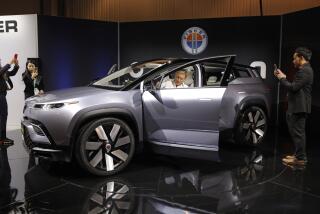Concept Vehicle Realizes Designer’s Dream
- Share via
Nick Pugh has found what he believes is the automotive future: Looking a bit like a golden-carapaced beetle crossbred with a lunar rover, it is gloriously noisy, highly interactive and, if Pugh ever gets it tuned just right, would move like a thoroughbred racing machine.
It seats two, but barely has storage space for one headed out on a short day trip. It won’t keep you dry in the rain or warm in the snow, and it runs on compressed natural gas rather than exotic fuels such as hydrogen or nuclear energy.
It cost Pugh and his sponsors almost $100,000--plus easily three times that in Pugh’s labor. The odds of it ever serving as more than a visual demonstration of one dreamer’s ideas are long indeed.
But Pugh doesn’t mind. In fact, it is to demonstrate his dream that he’s spent the last 12 years immersed in creating what he calls the personal concept car.
It now has a formal name, Xeno III (there was no Xeno I or II), and a biographer, Mark Christensen, who has just published a 380-page book, “Build the Perfect Beast,” that chronicles Pugh’s quest.
Of course, this is just Pugh’s vision--other dreamers of things automotive have conjured sleek rocket-ship designs, swoopy open roadsters with silent electric motors, roaring super cars with carbon-fiber skins and titanium skeletons, even wheel-less pods that float on cushions of air along electromagnetically-defined roadways.
Pugh figures there’s room for everyone in the future he foresees. “A car is a robotic skin that you wear,” he insisted. “It should represent your personality and style, just as jewelry and clothes do.”
That’s what Xeno is all about.
Pugh trained as a car designer at Pasadena’s Art Center College of Design but supports himself and his automotive pursuits by doing computer graphics for Hollywood movie makers and Madison Avenue product pushers. He turned to the entertainment industry to practice his art because he believed that working for a car company would be too confining.
“I wanted to be able to design the car I wanted, not the cars the marketing executives wanted,” he said.
Pugh is more futurist than pragmatist: His concept is meant to show what cars could look like if a futuristic “personal product manufacturing process” that he’s imagined could be made real.
Xeno has a skin of flat aluminum panels and clear glass, representative of carbon-based crystalline shapes that could be grown, he said, in a small hydrocarbon processing plant to fit the specifications of any vehicle design a customer wanted.
“It’s like the enormous and unimaginably expensive mainframe computers of the 1950s becoming the cheap, almost disposable PCs we all use today,” Pugh said.
To “grow” the first organic car in the first personal product manufacturing system might cost $2 million, but widespread use and development of the concepts, he said, could get the cost down to $1,000 or $1,500 per car. “Cheap enough so you could keep the same frame and running gear and change body styles with the seasons, like you change wardrobes,” he said.
Pugh’s manufacturing process . may never become reality, but Xeno is real, and it runs, although a tuning bug kept it from running well in all speed ranges the day we went for a drive.
Pugh used a 502-cubic-inch marine engine from General Motors, beefed it up with a supercharger, and linked it to the tires through a Corvette rear end and a dragster transmission powerful enough to handle the 500-plus horsepower output.
For fuel, he chose compressed natural gas (CNG) because it is more environmentally friendly than gasoline.
His patented chassis design incorporates a pair of carbon-fiber CNG storage tanks big enough to give Xeno the cruising range of a “normal” car, Pugh said. The chassis is made of chromolly steel and aluminum and incorporates race-derived independent front and rear suspension systems.
The car is open to the air because Pugh sees it as a “reduction design,” a distillate of what a car should be. “I wanted to do the first one in a way that would connect the driver to the road and to display the function of the vehicle, not cover it with styling elements,” he said.
So Xeno is skeletal by purpose. Clear glass panels in the nose and alongside the cabin enable driver and passenger to watch the road, to follow the ups and downs of the suspension members, to see cables stretch as the brakes are applied, to watch the longitudinally mounted shock absorbers compress and extend with each bump in the asphalt.
The design theme--organic, environmentally friendly, performance-oriented and interactive--holds together, and even if Xeno isn’t every car-lover’s dream, the fact that it runs establishes it as proof that dreams can come true.
“This car is about learning,” Pugh said. “It is about engineering and learning to understand how a car works.”
So he can realize his next dream. And the one after that.
As car makers from Henry Ford to Carroll Shelby and Steve Saleen attest, that’s what being a car dreamer is all about--turning the ephemeral into metal and rubber, cranking up the engine and hitting the road.






